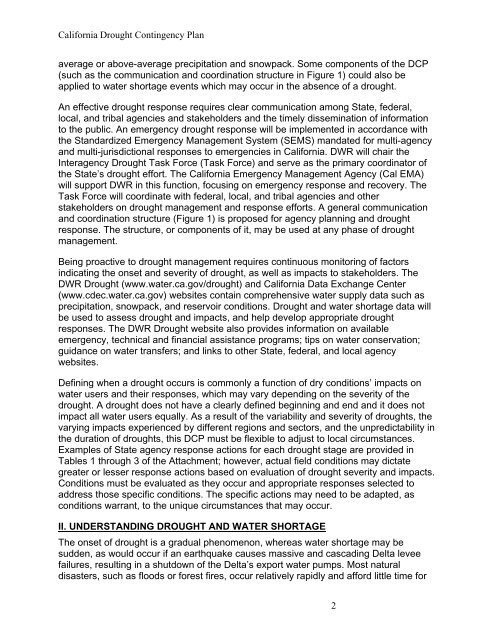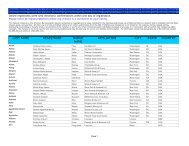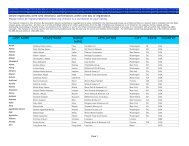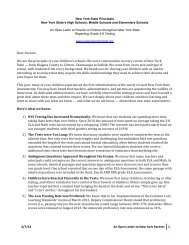Final_CA_Drought_Contingency_Plan-11-18-2010a
Final_CA_Drought_Contingency_Plan-11-18-2010a
Final_CA_Drought_Contingency_Plan-11-18-2010a
You also want an ePaper? Increase the reach of your titles
YUMPU automatically turns print PDFs into web optimized ePapers that Google loves.
California <strong>Drought</strong> <strong>Contingency</strong> <strong>Plan</strong>average or above-average precipitation and snowpack. Some components of the DCP(such as the communication and coordination structure in Figure 1) could also beapplied to water shortage events which may occur in the absence of a drought.An effective drought response requires clear communication among State, federal,local, and tribal agencies and stakeholders and the timely dissemination of informationto the public. An emergency drought response will be implemented in accordance withthe Standardized Emergency Management System (SEMS) mandated for multi-agencyand multi-jurisdictional responses to emergencies in California. DWR will chair theInteragency <strong>Drought</strong> Task Force (Task Force) and serve as the primary coordinator ofthe State’s drought effort. The California Emergency Management Agency (Cal EMA)will support DWR in this function, focusing on emergency response and recovery. TheTask Force will coordinate with federal, local, and tribal agencies and otherstakeholders on drought management and response efforts. A general communicationand coordination structure (Figure 1) is proposed for agency planning and droughtresponse. The structure, or components of it, may be used at any phase of droughtmanagement.Being proactive to drought management requires continuous monitoring of factorsindicating the onset and severity of drought, as well as impacts to stakeholders. TheDWR <strong>Drought</strong> (Hwww.water.ca.gov/droughtH) and California Data Exchange Center(www.cdec.water.ca.gov) websites contain comprehensive water supply data such asprecipitation, snowpack, and reservoir conditions. <strong>Drought</strong> and water shortage data willbe used to assess drought and impacts, and help develop appropriate droughtresponses. The DWR <strong>Drought</strong> website also provides information on availableemergency, technical and financial assistance programs; tips on water conservation;guidance on water transfers; and links to other State, federal, and local agencywebsites.Defining when a drought occurs is commonly a function of dry conditions’ impacts onwater users and their responses, which may vary depending on the severity of thedrought. A drought does not have a clearly defined beginning and end and it does notimpact all water users equally. As a result of the variability and severity of droughts, thevarying impacts experienced by different regions and sectors, and the unpredictability inthe duration of droughts, this DCP must be flexible to adjust to local circumstances.Examples of State agency response actions for each drought stage are provided inTables 1 through 3 of the Attachment; however, actual field conditions may dictategreater or lesser response actions based on evaluation of drought severity and impacts.Conditions must be evaluated as they occur and appropriate responses selected toaddress those specific conditions. The specific actions may need to be adapted, asconditions warrant, to the unique circumstances that may occur.UII. UNDERSTANDING DROUGHT AND WATER SHORTAGEThe onset of drought is a gradual phenomenon, whereas water shortage may besudden, as would occur if an earthquake causes massive and cascading Delta leveefailures, resulting in a shutdown of the Delta’s export water pumps. Most naturaldisasters, such as floods or forest fires, occur relatively rapidly and afford little time for2






